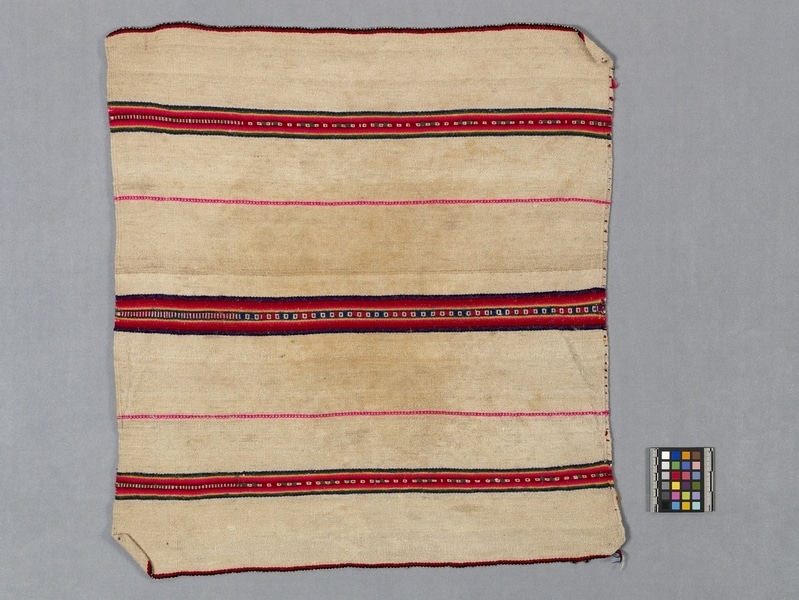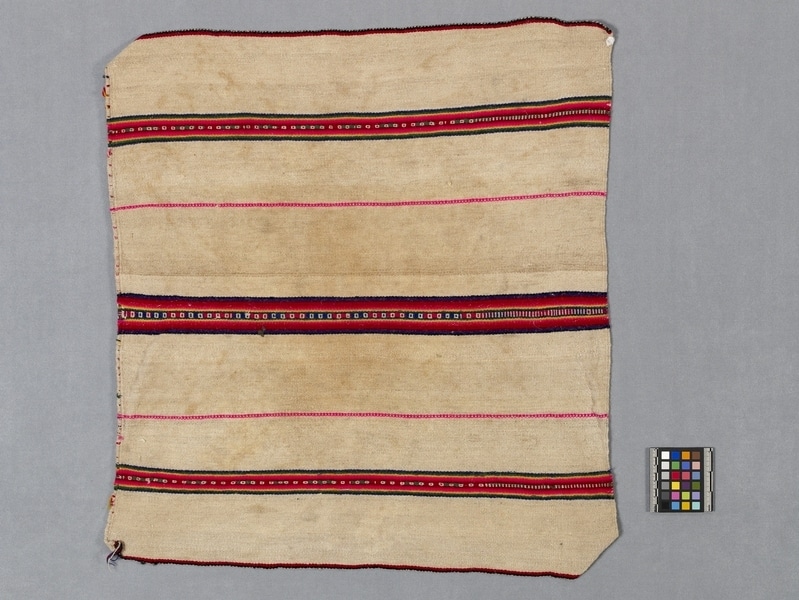Cloth Item Number: Sf981 from the MOA: University of British Columbia


Description
Cloth, rectangular, made of off-white woven wool with three multicoloured bands with a thin central band of white squares and repeated short stripes. Narrow bright pink stripes separate the bands. Two opposite selvedges are edged with black and red stripes.
History Of Use
Warp-faced fabrics with three or four selvedges are woven by women on the indigenous style loom, a staked-out horizontal ground loom, or an adjustable tension (body) loom. The technique and structure have pre-Conquest antecedents, and as in ancient times, the fabrics are used in their rectangular form without cutting or shaping. This style of unkuna is an all-purpose carrying cloth, frequently used for carrying a midday meal of boiled potatoes and dried fish. Men and women use unkunas for carrying smaller things in a hand bundle. Young girls sometimes use unkunas for carrying things on their backs.
Narrative
Woven and used by Silvia Yucra Huatta, a young married woman related by marriage to the family from whom most of the Taquile collection came. She is a sister of Gonzalo Yucra Huatta.
Specific Techniques
Plain colour areas or stripes are warp-faced plain weave. The weave structure of the 3 stripes with squares is a float weave derived from a turned 2/1 horizontal herringbone with floats forming squares.
Cultural Context
carrying cloth
Item History
- Made by Silvia Yucra Huatta (Maker) in Taquile, Puno, Peru during 1978
- Collected by Mary Frame during 1982
- Owned by Mary Frame before February 10, 1983
- Received from Mary Frame (Seller) and Museum of Anthropology Shop Volunteers (Funding source) on February 10, 1983
What
- Name
- Cloth
- Identification Number
- Sf981
- Type of Item
- cloth
- Material
- wool fibre, alpaca wool fibre, synthetic fibre and dye
- Manufacturing Technique
- woven, spun, retwisted, dyed and plied
- Overall
- height 63.5 cm, width 69.0 cm
Who
- Culture
- Quechua
- Creator
- Silvia Yucra Huatta (Maker)
- Field Collector
- Mary Frame
- Previous Owner
- Mary Frame
- Received from
- Mary Frame (Seller) and Museum of Anthropology Shop Volunteers (Funding source)
Where
- Holding Institution
- MOA: University of British Columbia
- Made in
- Taquile, Puno, Peru
When
- Creation Date
- during 1978
- Collection Date
- during 1982
- Ownership Date
- before February 10, 1983
- Acquisition Date
- on February 10, 1983
Other
- Item Classes
- textiles
- Condition
- good
- Accession Number
- 0861/0027